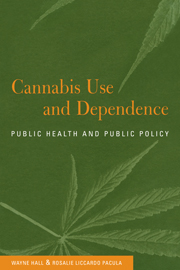Book contents
- Frontmatter
- Dedication
- Contents
- List of figures and tables
- Foreword
- Acknowledgements
- 1 Introduction
- Section 1 Cannabis the drug and how it is used
- Section 2 The health effects of cannabis
- Section 3 The psychological effects of chronic cannabis use
- Section 4 Effects on adolescent development
- Section 5 Harms and benefits of cannabis use
- Section 6 The effectiveness and costs of cannabis prohibition
- Section 7 Policy alternatives
- Appendix 1
- Appendix 2
- References
- Index
Section 4 - Effects on adolescent development
Published online by Cambridge University Press: 05 July 2016
- Frontmatter
- Dedication
- Contents
- List of figures and tables
- Foreword
- Acknowledgements
- 1 Introduction
- Section 1 Cannabis the drug and how it is used
- Section 2 The health effects of cannabis
- Section 3 The psychological effects of chronic cannabis use
- Section 4 Effects on adolescent development
- Section 5 Harms and benefits of cannabis use
- Section 6 The effectiveness and costs of cannabis prohibition
- Section 7 Policy alternatives
- Appendix 1
- Appendix 2
- References
- Index
Summary
For understandable reasons, community concern about the effects of cannabis use on adolescents has played a central role in debates about cannabis policy. One concern that has dominated the debate is whether adolescents who use cannabis are more likely, as a result of using cannabis, to use other more dangerous illicit drugs, such as cocaine and heroin (Goode, 1974; DuPont, 1984; Kleiman, 1992). This has been described as the ‘gateway hypothesis’.
A second set of concerns has been about the effects that adolescent cannabis use may have on psychosocial outcomes, such as, educational achievement, employment, involvement in crime, and mental health. A reasonable concern is that regular cannabis intoxication may interfere with the adolescent's transition from childhood to adulthood by impairing school performance, and adversely affecting interpersonal relationships and important life choices, such as whom and when to marry, and what occupation to pursue (Polich et al., 1984; Baumrind and Moselle, 1985).
Because of concern about the adverse effects of adolescent cannabis use in the USA in the late 1970s the US government funded a number of prospective studies of the antecedents and consequences of adolescent drug use (Kaplan et al., 1984; Kandel, 1988; Newcomb and Bentler, 1988). These, and subsequent studies in the USA and other countries, have begun to distinguish the effects of users’ preexisting personal characteristics and the effects of their cannabis and other drug use on their risks of using other illicit drugs, their school performance, and their psychosocial adjustment more generally. The most important of these studies are reviewed in the following two chapters.
- Type
- Chapter
- Information
- Cannabis Use and DependencePublic Health and Public Policy, pp. 101 - 103Publisher: Cambridge University PressPrint publication year: 2002



